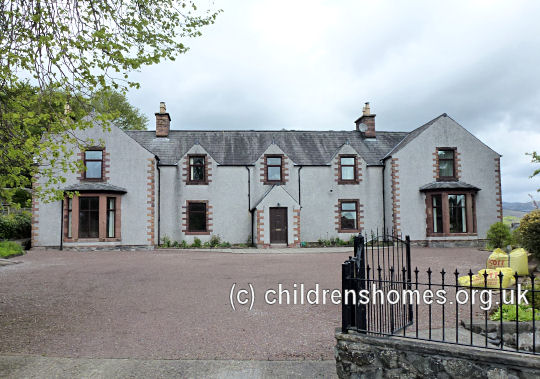Industrial Home for Girls, Newton Stewart, Wigtonshire, Scotland
An Industrial Home for Girls was established in around 1859 at Newton Stewart, in the parish of Penninghame, Wigtonshire. Its committee raised funds to erect a new building at Windsor Road, Newton Stewart, where up to 40 girls could be accommodated. On January 17th, 1862, the Home was certified as an Industrial School, allowing it to receive girls aged from 5 to 12 years sentenced by the courts to a period of detention. In 1863, the premises were improved by the addition of a dormitory and schoolroom, and enlargement of the laundry. At this date, the matron was Miss Pattinson (sometimes recorded as Paterson) the schoolmistress, Miss Guvine, the latter being succeeded by Miss McTier in 1865, Mrs McIntrye in 1867, and Miss Ewing in 1868.
In addition to classroom education, the girls received instruction in needlework, knitting and housework, and the older ones were employed in the laundry. Because many of the girls were quite young, the laundry work was largely confined to the Home's own washing

Former Industrial Home for Girls, Newton Stewart, 2015. © Peter Higginbotham
In 1877, the Home received a contingent of girls from the Dumfries Industrial School which was changing from being a mixed establishment to one for boys only. In the same year, Miss Stewart took over as schoolmistress, and it was noted that that the Home rented a house at the seaside for a month each summer to give the girls a holiday. In 1878, Miss Jane McKay (or Mackay) became matron, with Miss Colquhoun as her assistant.

Former Industrial Home for Girls, Newton Stewart, 2015. © Peter Higginbotham
In 1892, a house was secured at the Isle of Whithorn to which the Home migrated to for three months each summer.
A report in 1897 noted that the girls' conduct was generally good and that little corporal punishment was administered. Having porridge for supper or being sent to bed early were the usual punishments in use. The 'mark system' of rewards and privileges that was operated at some institutions was not used at Newton Stewart, although prize money was awarded at the end of the year.
After 22 years' service, Miss McKay resigned as matron and was succeeded by Miss Joan Duff who was still in post in 1911.
In May, 1929, a fire broke out at the Home while the girls were in bed. A local police officer, Constable Keiller, prevented the fire from becoming serious when, armed with a small axe, he climbed onto the roof and broke away a portion of a burning beam.
In 1933, the establishment was redesignated as an Approved School, one of the new institutions established under the Children and Young Persons Act of 1933 to replace Reformatories and Industrial Schools. Windsor Lodge, as the School became known, was certified to accommodate up to 40 girls aged 5 to 14. The superintendent in 1935 was Miss Munro.
In 1980, the school became mixed. The first boy admitted was John McWilliam, whose sister was already there. Windsor Lodge Children's Home then provided accommodation for up to 12 children between the ages of 5 and 16 years.
Records
Note: many repositories impose a closure period of up to 100 years for records identifying individuals. Before travelling a long distance, always check that the records you want to consult will be available.
- None identfied at present — any information welcome.
Census
Bibliography
- Higginbotham, Peter Children's Homes: A History of Institutional Care for Britain's Young (2017, Pen & Sword)
- Mahood, Linda Policing Gender, Class and Family: Britain, 1850-1940 (1995, Univeristy of Alberta Press)
- Prahms, Wendy Newcastle Ragged and Industrial School (2006, The History Press)
- Higginbotham, Peter Children's Homes: A History of Institutional Care for Britain's Young (2017, Pen & Sword)
- Hyland,Jim Yesterday's Answers: Yesterday's Answers: Development and Decline of Schools for Young Offenders (1993, Whiting and Birch)
- Millham, S, Bullock, R, and Cherrett, P After Grace — Teeth: a comparative study of the residential experience of boys in Approved Schools (1975, Chaucer Publishing)
Links
- None noted at present.
Except where indicated, this page () © Peter Higginbotham. Contents may not be reproduced without permission.


